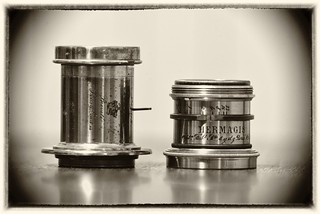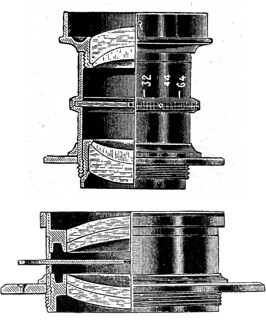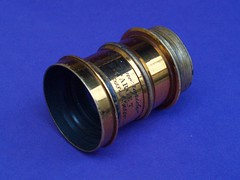Difference between revisions of "Rapid Rectilinear"
(turned non-displaying photobucket pic into link footnote; one CP -> CW pool; added missing attribution & rights) |
m (Moved Glossary to the top of the page) |
||
| (12 intermediate revisions by 6 users not shown) | |||
| Line 1: | Line 1: | ||
| + | {{glossary}} | ||
| + | {|class=floatright | ||
| + | | | ||
| + | {{Flickr_image | ||
| + | |image_source= http://www.flickr.com/photos/heritagefutures/10935828444/in/pool-camerawiki/ | ||
| + | |image= http://farm6.staticflickr.com/5478/10935828444_1a839c5a05_n.jpg | ||
| + | |image_align= right | ||
| + | |image_text= Aplanats by [[Derogy]] and [[Hermagis]] | ||
| + | |image_by= Dirk HR Spennemann | ||
| + | |image_rights= wp | ||
| + | }} | ||
| + | |- | ||
| + | | | ||
| + | {{Flickr image | ||
| + | | image_source=http://www.flickr.com/photos/uwe_kulick/2800228159/in/pool-camerawiki/ | ||
| + | | image=http://farm4.static.flickr.com/3031/2800228159_54e2bd7b43_n.jpg | ||
| + | | image_align=right | ||
| + | | image_text=Aplanat and wide angle Aplanat<br/> | ||
| + | |scan_by=Uwe Kulick | ||
| + | |image_rights=pd | ||
| + | }} | ||
| + | |} | ||
| + | A '''Rapid Rectilinear''' [[lens]], or '''RR lens''', is a symmetrical pair of cemented [[achromatic lens|achromatic]] doublets. It was introduced by [[Dallmeyer]] in 1866. At the same time [[Steinheil]] invented a similar construction, the '''Aplanat''' lens. The outer lens elements of the two lens groups are concave [[meniscus lens]] elements, the inner lens elements are convex meniscus lens elements, made of another sort of glass. This lens construction reduces effectively radial distortion. Dallmeyer's original '''Rectilinear''' wide angle lens's rear lens group is smaller in diameter than the front lens group. The Rapid Rectilinear and the Aplanat each have two equal-sized groups. Steinheil offered a landscape Aplanat, a portrait Aplanat and a wide angle Aplanat. Many makers have made lenses of this design. | ||
| + | |||
| + | |||
| + | == Links == | ||
| + | * [http://en.wikipedia.org/wiki/Rapid_Rectilinear Wikipedia article] | ||
| + | * [http://www.johnloomis.org/eop601/notes/history/rapid/rapid.html Article by John Loomis] | ||
| + | * [http://i916.photobucket.com/albums/ad6/tamasflexoptics/Petzval/Dagor/Aplanat/aplanat.png Images] of brass-barrel rapid aplanat | ||
| + | |||
| + | {| | ||
| + | | | ||
{{Flickr image | {{Flickr image | ||
| image_source=http://www.flickr.com/photos/uwe_kulick/2909415885/in/pool-camerawiki | | image_source=http://www.flickr.com/photos/uwe_kulick/2909415885/in/pool-camerawiki | ||
| image=http://farm4.static.flickr.com/3088/2909415885_d3dbd80fd1_m.jpg | | image=http://farm4.static.flickr.com/3088/2909415885_d3dbd80fd1_m.jpg | ||
| − | | image_align= | + | | image_align=left |
| image_text=Rectiligne rapide | | image_text=Rectiligne rapide | ||
|image_by=Uwe Kulick | |image_by=Uwe Kulick | ||
|image_rights=wp | |image_rights=wp | ||
}} | }} | ||
| + | |} | ||
| − | |||
| − | + | [[Category:Lenses]] | |
| − | |||
| − | |||
| − | |||
| − | |||
| − | |||
| − | |||
| − | |||
| − | |||
| − | |||
| − | |||
| − | |||
| − | |||
| − | |||
| − | |||
| − | |||
| − | |||
| − | |||
| − | |||
| − | |||
| − | |||
| − | |||
| − | |||
| − | |||
| − | |||
| − | |||
| − | |||
| − | |||
[[Category:R]] | [[Category:R]] | ||
[[Category:1839-1889]] | [[Category:1839-1889]] | ||
Latest revision as of 03:51, 23 March 2023
| ||
|
A Rapid Rectilinear lens, or RR lens, is a symmetrical pair of cemented achromatic doublets. It was introduced by Dallmeyer in 1866. At the same time Steinheil invented a similar construction, the Aplanat lens. The outer lens elements of the two lens groups are concave meniscus lens elements, the inner lens elements are convex meniscus lens elements, made of another sort of glass. This lens construction reduces effectively radial distortion. Dallmeyer's original Rectilinear wide angle lens's rear lens group is smaller in diameter than the front lens group. The Rapid Rectilinear and the Aplanat each have two equal-sized groups. Steinheil offered a landscape Aplanat, a portrait Aplanat and a wide angle Aplanat. Many makers have made lenses of this design.
Links
- Wikipedia article
- Article by John Loomis
- Images of brass-barrel rapid aplanat
|


